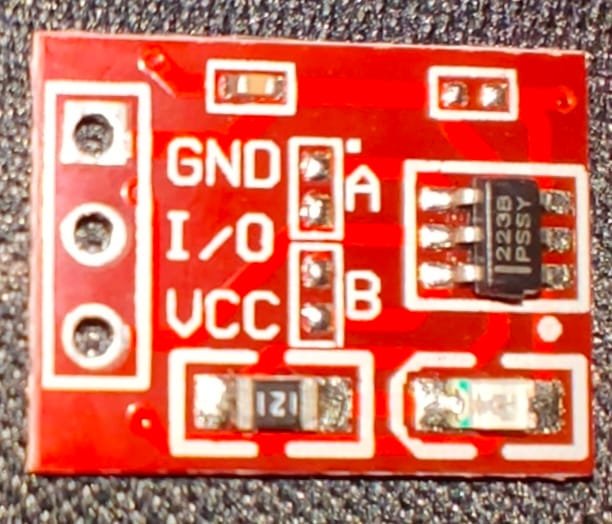
Introduction
The TTP223 Red Digital Touch Sensor Module is a highly versatile and compact capacitive touch switch module. It replaces traditional mechanical switches with a touch-sensitive pad, making it ideal for a variety of applications such as DIY projects, interactive systems, and embedded electronics. This sensor is widely used due to its low cost, high sensitivity, and easy integration with microcontrollers like Arduino and Raspberry Pi.
In this detailed guide, we will cover:
- Technical Specifications
- Working Principle
- Key Features
- Applications
- Comparison with Other Touch Sensors
- Wiring and Code Examples
- Advantages and Limitations
- Alternatives to the TTP223
Technical Specifications
| Feature | Specification |
|---|---|
| Operating Voltage | 2V – 5.5V DC |
| Operating Current | <1.5μA (standby mode) |
| Response Time | 60ms (fast mode), 220ms (low power mode) |
| Output Mode | Active High or Active Low (configurable) |
| Touch Sensitivity | Adjustable through PCB design |
| Operating Temperature | -40°C to 85°C |
| PCB Size | 24mm x 24mm x 7.2mm |
| Interface | 3 Pins (VCC, I/O, GND) |
How the TTP223 Works
The TTP223 module is based on a capacitive touch sensing IC that detects changes in capacitance when a conductive object (such as a finger) comes into contact with the touchpad.
Step-by-Step Operation:
- No Touch: When the module is powered on and no touch is detected, the output remains low (or high depending on the mode selected).
- Touch Detected: When a finger touches the sensor area, the capacitance changes, triggering the sensor to output a HIGH (or LOW) signal.
- Release: When the finger is removed, the sensor returns to its default state after a brief delay.
This simple mechanism makes it a reliable and durable alternative to mechanical buttons, which may wear out over time.
Features of the TTP223
- Capacitive Sensing Technology:
- Eliminates the need for mechanical buttons.
- Responds to light touches.
- Low Power Consumption:
- Consumes less than 1.5μA in standby mode, making it ideal for battery-powered applications.
- Configurable Output Modes:
- Momentary (default): The output remains high as long as the touch is detected.
- Toggle Mode: The output state changes on each touch (configurable by soldering jumper pads on the PCB).
- Adjustable Sensitivity:
- The sensor’s sensitivity can be modified by adding an external capacitor.
- Compact and Easy to Integrate:
- Small PCB size allows it to fit into compact devices.
- Wide Voltage Compatibility:
- Works with 2V – 5.5V, making it suitable for Arduino, ESP32, Raspberry Pi, and other microcontrollers.
Pin Configuration and Wiring
The TTP223 touch sensor has three pins:
| Pin | Function |
|---|---|
| VCC | Power Supply (2V – 5.5V) |
| I/O | Digital Output (Active High/Low) |
| GND | Ground Connection |
Connecting to Arduino
| TTP223 Pin | Arduino Pin |
|---|---|
| VCC | 5V or 3.3V |
| I/O | Digital Pin 2 |
| GND | GND |
Applications of TTP223
The TTP223 capacitive touch sensor is widely used in various applications, including:
- Touch-Based Switches
- Replaces mechanical push buttons in electronics.
- Interactive Projects
- Used in smart home automation.
- Security and Access Control
- Can be used as a hidden switch for security systems.
- Wearable Devices
- Used in smart gadgets for touch-based control.
- Automotive Controls
- Used in dashboard controls of modern vehicles.
- Consumer Electronics
- Used in MP3 players, appliances, and remote controls.
Comparison: TTP223 vs Other Touch Sensors
| Feature | TTP223 | TTP229 (Multiple Keys) | ESP32 Touch GPIO | Capacitive DIY Pads |
|---|---|---|---|---|
| Number of Touch Points | 1 | Up to 16 | Multiple GPIOs | Custom |
| Power Consumption | Low | Moderate | Moderate | Variable |
| Response Time | Fast | Fast | Fast | Depends on Design |
| Microcontroller Compatibility | High | High | High | Custom |
| Sensitivity Adjustment | Yes | Yes | Yes | Custom |
| Best For | Basic touch controls | Keypads | IoT, Wearables | DIY Custom Applications |
Alternatives to TTP223
Better Alternatives:
- TTP229 (Multi-Touch Keypad): Supports multiple touch inputs.
- ESP32 Capacitive Touch GPIOs: Eliminates the need for external sensors.
- MPR121 (Capacitive Touch Controller): Supports up to 12 touch inputs.
Worse Alternatives:
- Mechanical Push Buttons: Prone to wear and tear over time.
- Resistive Touch Sensors: Less responsive and less durable.
Example Code for Arduino
const int touchPin = 2;
void setup() {
pinMode(touchPin, INPUT);
Serial.begin(9600);
}
void loop() {
int touchState = digitalRead(touchPin);
if (touchState == HIGH) {
Serial.println("Touch detected!");
}
delay(100);
}
Advantages and Limitations
Advantages:
✔️ No Mechanical Wear – Durable and long-lasting.
✔️ Easy to Use – Simple wiring and coding.
✔️ Low Power – Ideal for battery-powered applications.
✔️ Highly Responsive – Fast response time.
Limitations:
❌ Limited to One Touch Input (use TTP229 for multiple inputs).
❌ May Require Calibration for different materials or environmental conditions.
❌ Sensitive to Noise in some environments.
Conclusion
The TTP223 Red Digital Touch Sensor Module is an excellent replacement for traditional push-button switches. Its low cost, low power consumption, and high sensitivity make it an ideal choice for a wide range of applications, from simple DIY projects to complex embedded systems.
If you’re working on a project that needs a reliable and compact touch sensor, the TTP223 is a great choice!
Would you like to explore more advanced touch solutions? Let us know in the comments!


